Manual Handling Risk Management
Back injuries and back pain are something that most people suffer during their lifetime, with many of these injuries originating in the workplace. In fact, recent Health and Safety Authority (HSA) data confirms that manual handling remains a primary cause of non-fatal accidents. Statistics from 2021 show manual handling was the single most common trigger, accounting for 32% of all non-fatal injuries. These incidents are a leading cause of back injuries, which were the most common specific injury reported in 2022, representing 26% of all accidents at work. It, therefore, makes sense for any company to focus on reducing all manual handling risks as much as possible to ensure employees are protected from these unnecessary injuries.
What is manual handling?
It is the carrying, transporting or manipulation of a load by an employee from one place to another. It involves several activities including pushing, pulling, carrying, throwing and lifting of loads. Manual handling injuries don’t just occur in occupations that have a high level of lifting (like construction, nursing, factory work) they can easily occur during routine office work.
Legal Duties and The Cost of Non-Compliance
Employers have a legal obligation (The Safety, Health and Welfare at Work, General Applications Regulations 2007) to protect the health and safety of employees when it comes to the area of manual handling.
The following are the requirements of this specific legislation:
- Manual handling risk assessments should be carried out for all existing manual handling tasks. Once this is done, an informed decision on what can be eliminated or reduced can be made.
- Consider using mechanical means or other means to avoid or reduce the need for manual handling by employees. This can include the re-design of a work area or introducing a mechanical aid.
- Ensure all employees are trained in manual handling and given the relevant instruction for the tasks that they carry out in their daily work.
The legal requirements for task-specific assessment and training are not just administrative; failure to comply has significant consequences. This was highlighted in a 2024 High Court case where an employee suffered a serious back injury lifting a 50kg bag. The bag had a warning symbol indicating a two-person lift, but the court found this was not a sufficient control measure.
The employer was found liable because they had failed to provide:
- A specific risk assessment for that task.
- A safe system of work (such as providing lifting equipment or enforcing a two-person team).
- Adequate training relevant to handling such a heavy, specific load.
This case underscores that generic training is not a valid legal defence. Assessments and controls must be specific to the actual tasks employees perform.
Risk factors for injury
There are two factors that must be considered: occupational and non-occupational.
Occupational: Repetitive manual handling, repetitive heavy lifting, reaching, bending or twisting, exposure to continuous whole-body vibration, or a continued static posture.
Non-occupational: Poor overall health (lack of exercise, overweight), poor posture, smoking, age, and psychosocial stressors.
Injuries associated with manual handling
It’s not just the back that can be affected. Manual handling can affect the neck, upper limbs (shoulder, arm, elbow wrist, fingers), and lower limbs (legs, knees, ankles). Repetitive movement that requires force can cause damage to the musculoskeletal system. Injury can happen suddenly or accumulatively over time. Examples include muscle strains and sprains, injury to ligaments and discs in the back, injuries to soft tissues in the wrists, shoulders, arms, legs and chronic pain.
How to prevent Manual Handling injuries
As with any hazard, elimination is always the best option. You may find it helpful first to create a list of all the manual handling tasks carried out in your workplace.
Assessing manual handling
If you cannot eliminate the hazard, a manual handling assessment must be carried out. The assessment reviews the Task, the Individual, the Load and the Environment (T.I.L.E).
Task – What does the activity involve? Twisting, stooping, bending, pushing, pulling, or team handling.
Individual – Employees have varied physical capacity. Specific assessments should be carried out for pregnant employees or those with reduced physical capacity.
Load – Is it heavy, hard to grasp, sharp, hot, cold, or an unusual shape?
Environment – Consider lighting, floor condition, slip/trip hazards, space constraints, and hot or cold environments.
Employees must always be consulted when carrying out risk assessments. Once you have completed your risk assessments and put controls in place, you must ensure your employees are fully trained in manual handling. This is a requirement of Health and Safety legislation. EazySAFE provides both expert training and consultancy on this topic to help companies meet their obligations.
Then all that is left to do is review your assessments regularly and ensure your employees receive refresher training when they are due. To assist with this, EazySAFE offers new bite-size courses perfect for refresher training.

Discover our Safety Training Platform
Train your employees anytime, anywhere with our environmental, health, safety and wellness training platform.

TAILORED TRAINING
Discover our safety training courses and ehs onboardings, which can be customised and offered in several languages.

SAFETY MANAGEMENT
Ensure the distribution of your safety policy by training your permanent, temporary or seasonal staff.

GLOBAL MONITORING
Simplify the management of your safety policy thanks to the numerous dashboards and training reports.
